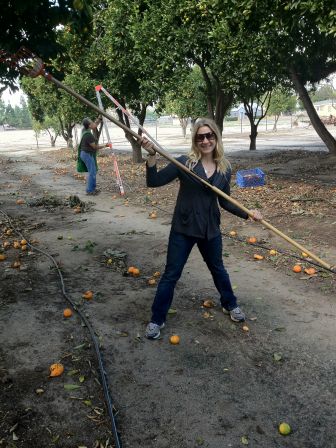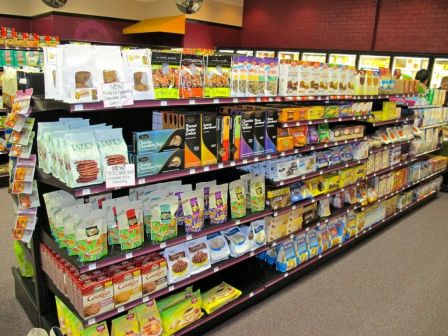Wrote an article for the SM Observer on the Good Food Festival.
The Good Food
Festival:
Figuring How Organic
and Local Can Save the World One Bite at a Time
Local.
Organic. Really last week’s
Good Food Festival was a four-day long tribute to the importance of these
words.
And yes, these are words that are thrown around like no
other in Santa Monica. But where
do they fit in the real world? And how can they save the world? (Which as Molly Gean of Harry’s Berries
noted was a pretty tall order to fill).
GFF’s Local/Organic panel housed a variety of different
viewpoints from the aforementioned Gean (owner of a 40 acre organic strawberry
farm) to Will Daniels Senior Vice President for Food Safety
at Earthbound Farm (with 37,000 acres in total, the largest organic company out
there) to Bruce Palma founder of Co-Opportunity Natural Foods (which as been
selling local organic food for 37 years) to Phil McGrath of McGrath Family
Farms (which has farming for five generations going from organic to chemical
then choosing to go back to organic again). The panel was moderated by Debbie Barker of the Center for
Food Safety (an environmental and public health organization
which has initiated legal actions against the FDA and EPA to preserve the
integrity of the food supply).
So what’s the big deal with local and organic?
In the world of food sales organic is only 4% penetration in
the market and 9% of fruit and vegetables. But it’s also one of the fastest growing sections of the
food industry.
Why does it matter if our food comes from the earth or from
chemicals?
The answer is really two-fold health and taste. The importance of organic taste is
something that Santa Monica Farmers Market patrons know firsthand, along with
chefs who have the market’s produce flow to them through specialty food buyers
to locations as far as Scottsdale, AZ and Las Vegas, NV. When Molly Gean referred to her
strawberries she noted, “They’re smaller, our yields are lower, our cost is
higher, but they taste so much better.”
But while most people agree that a organic strawberry will
taste better than a GMO-ed one, they will usually with their next breath talk
about how we all can’t live on organic farming. “If the world only ate organic, we’d all starve to death,”
is a pretty popular battle cry.
But Debbie Barker of the Center for Food Safety noted that
in May a United Nations report, titled Agro-ecology and the Right to Food, revealed that small-scale sustainable farming would even double
food production within five to 10 years in places where most hungry people on
the planet live.
“We won’t solve hunger and
stop climate change with industrial farming on large plantations,” wrote Olivier
De Schutter, UN Special Rapporteur on the right to food. “The solution lies in
supporting small-scale farmers’ knowledge and experimentation, and in raising
incomes of smallholders so as to contribute to rural development.”
The UN report suggested
moving away from the overuse of oil in farming, a problem that is magnified in
the face of rising prices due to unrest in the Middle East. The focus should instead
be on agroecology, or eco-farming. “Agroecology seeks to improve the
sustainability of agroecosystems by mimicking nature instead of industry,” he
continued. Barker also noted the
World Bank was to be coming out with a similar study in the coming months.
But that doesn’t mean that
organic farming will be easy or cheap.
“Organic is more of an art than a science,” stated Phil McGrath of
McGrath Family Farms. “There’s a lot of problems, but the taste does give an
edge. I was a chemical farmer;
they are difficult not to be. I
went through my learning curve with growing in season. The only way to grow organic and
survive is through diversification.”
“America grows the cheapest food in the world,” he continued. “We need to pay more for good clean
food than that. Our father’s
generation was so excited about chemicals. But it’s caused so many issues. You don’t have a quick fix; it comes part and parcel without
the chemicals. Yes yields
aren’t as high but it comes out in the taste.”
“I think people need to understand the concept of fruit and
vegetables being the primary part of dinner,” noted Bruce Palma. “Most people don’t think about it
that way so they’re not willing to spend the money on it the way they do on
their meat.”
“Joel Salatin says on
average that we spend 18% on health care and 9% on food,” noted Daniels of
Earthbound. “Decades ago it was
different, and I believe it’s because of conventional agriculture. I would love to see it flip again. “ Not only for the health of the people
but also for the health of the land.
“Industrial agriculture consumes 70% of fresh water,” noted Barker. “30% of greenhouse gases are due to
global industrial farming.“
“Global warming is created because of unbalanced eco-systems,”
expanded Daniels further. “Organic
is just that: a balanced eco-system. In 2011 alone Earthbound’s avoiding the use of over
333,000 pounds of toxic and persistent pesticides and 11.2 million pounds of
synthetic fertilizer. We’re
conserving an estimated 1.8 million gallons of petroleum by avoiding the use of
petroleum-based pesticides and fertilizers. We’re fighting global warming by absorbing as much
carbon dioxide, a greenhouse gas, as taking more than 7,800 cars off the road.”
But doing the right thing doesn’t make life easy. “Crop
rotation is the key,” noted Daniels.
“Mono cropping is a bad idea all around. Organic farming feeds the soil not the crop.” “Being organic forces you to
diversify,” noted Phil McGrath.
“It’s very hard to be a mono-cropper and be organic. For example, if you’re going to
do strawberries organically you “should” wait seven years before you do another
strawberry crop. I’m able to do 4
years before plantings.” Which can
be a hard thing to do if you only have 300 acres to work with and a quarter of
it can’t be used for another four years.
It
was also noted that as we approach 2012 we need to start to rally in regards to
the Farm Bill.
What’s
the Farm Bill you ask?
The
Farm Bill is a $300 billion piece of legislation that is passed every 5 years
and helps to provide the structure of agriculture ad food policy in the
U.S. As Phil McGrath noted, “Yes
it’s boring but its what sets policy. I can only hope everyone looks at the Farm Bill. 75% goes to nutrition and food
stamps. The other part is
subsidies. That’s the part we need
to focus on, we need to apply pressure for some of that to go to sustainable
farming.“
“I hope progress will move quicker,” stated Daniels. “The people who make the needle move
are the constituents and the
lobbyists. And right now, the
biggest and baddies are speaking to your representatives. Monsanto spends 50 million in
lobbying. They have 100
lobbyists, that are identifiable.
That doesn’t even count the groups.” And their heavy hand can be found in America’s crops. “90% of corn in the US is
genetically modified,” noted Barker.
90-95% of sugar beets are GMOs”
“The organic consumer needs to speak up. They need to tell their representatives
what’s important,” continued Daniels.
“I’m sorry to put the onus on you guys,” finished Gean. “But you have your love of
farmers markets. You need to
spread the word.”
“It’s really all up to you. Our fate is in your hands.”
Kat Thomas is a Santa
Monica food writer who has been inspired to learn more about the Food
Bill. You can see more of
her writings at edibleskinny.com









